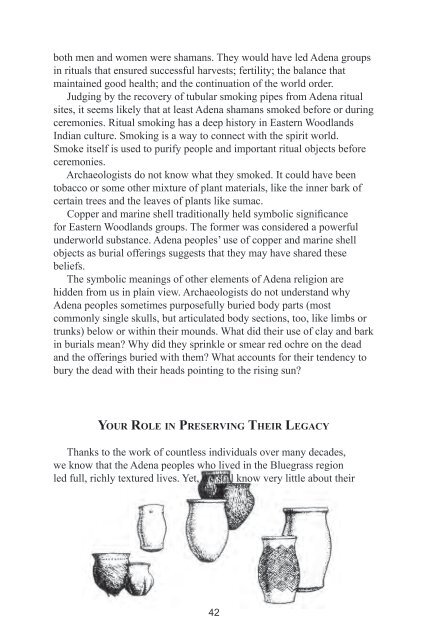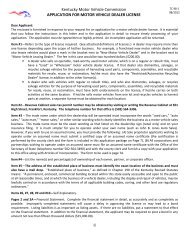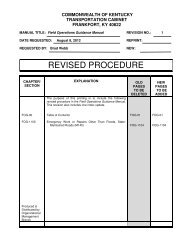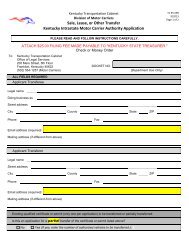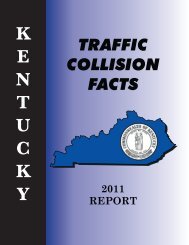woodland period moundbuilders of the bluegrass - Kentucky ...
woodland period moundbuilders of the bluegrass - Kentucky ...
woodland period moundbuilders of the bluegrass - Kentucky ...
- No tags were found...
Create successful ePaper yourself
Turn your PDF publications into a flip-book with our unique Google optimized e-Paper software.
oth men and women were shamans. They would have led Adena groupsin rituals that ensured successful harvests; fertility; <strong>the</strong> balance thatmaintained good health; and <strong>the</strong> continuation <strong>of</strong> <strong>the</strong> world order.Judging by <strong>the</strong> recovery <strong>of</strong> tubular smoking pipes from Adena ritualsites, it seems likely that at least Adena shamans smoked before or duringceremonies. Ritual smoking has a deep history in Eastern WoodlandsIndian culture. Smoking is a way to connect with <strong>the</strong> spirit world.Smoke itself is used to purify people and important ritual objects beforeceremonies.Archaeologists do not know what <strong>the</strong>y smoked. It could have beentobacco or some o<strong>the</strong>r mixture <strong>of</strong> plant materials, like <strong>the</strong> inner bark <strong>of</strong>certain trees and <strong>the</strong> leaves <strong>of</strong> plants like sumac.Copper and marine shell traditionally held symbolic significancefor Eastern Woodlands groups. The former was considered a powerfulunderworld substance. Adena peoples’ use <strong>of</strong> copper and marine shellobjects as burial <strong>of</strong>ferings suggests that <strong>the</strong>y may have shared <strong>the</strong>sebeliefs.The symbolic meanings <strong>of</strong> o<strong>the</strong>r elements <strong>of</strong> Adena religion arehidden from us in plain view. Archaeologists do not understand whyAdena peoples sometimes purposefully buried body parts (mostcommonly single skulls, but articulated body sections, too, like limbs ortrunks) below or within <strong>the</strong>ir mounds. What did <strong>the</strong>ir use <strong>of</strong> clay and barkin burials mean? Why did <strong>the</strong>y sprinkle or smear red ochre on <strong>the</strong> deadand <strong>the</strong> <strong>of</strong>ferings buried with <strong>the</strong>m? What accounts for <strong>the</strong>ir tendency tobury <strong>the</strong> dead with <strong>the</strong>ir heads pointing to <strong>the</strong> rising sun?YOUR ROLE IN PRESERVING THEIR LEGACYThanks to <strong>the</strong> work <strong>of</strong> countless individuals over many decades,we know that <strong>the</strong> Adena peoples who lived in <strong>the</strong> Bluegrass regionled full, richly textured lives. Yet, we still know very little about <strong>the</strong>ir42


